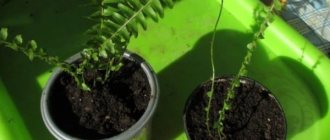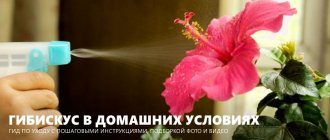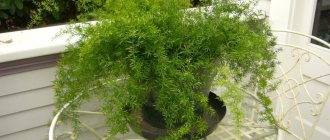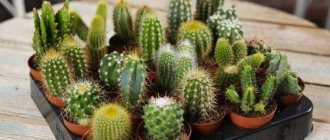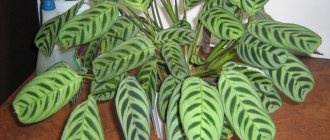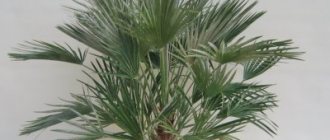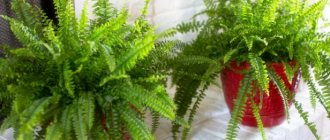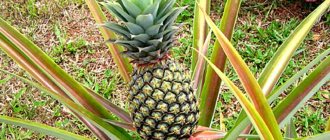- home
- Plant catalog
- Decorative foliage
Reading time: 9 minutes
14096
There are many signs and superstitions associated with Dracaena Sander. This beautiful indoor plant is often called lucky bamboo, although it has nothing in common with this crop except its appearance.
Many people believe that Dracaena Sander attracts good luck and happiness to the family, but no one knows whether this is true. An indoor palm tree from the Dracaena family will perfectly complement the interior of any living space.
Pseudobamboo is unpretentious and hardy , adapts well to any growing conditions, but you need to know some of the nuances of caring for this plant.
- Bamboo exterior of a super-hardy palm
- Lucky bamboo and other popular varieties of Dracaena Sander
- Features of cultivation and care Required lighting
- Air temperature
- Subtleties of growing in water and hydrogel
- Feeding methods
- Trimming technology
- Transplanting lucky bamboo
- Bamboo of happiness from apical cuttings
Description of Dracaena Sander
Indoor bamboo looks similar to regular bamboo, but has large leaves. It won't require too much effort. Dracaena Sander needs proper care: abundant and frequent watering, sufficient lighting.
In our stores, Dracaena Sander is often sold as “bamboo of happiness” or “Lucky Bamboo”
Origin of Dracaena Sandera
But this is not at all the same bamboo that came to Europe from China and Japan at the beginning of the 19th century. Despite the fact that scientists have bred more than 100 species of bamboo that can grow well in European conditions, Dracaena Sander does not belong to any of these species. By and large, it is not bamboo at all. In fact, the plant belongs to the asparagus family.
The fleshy stem is the main difference between Dracaena Sander and bamboo
Signs and superstitions
According to the teachings of Feng Shui, indoor bamboo can attract good luck and prosperity to the home and positively influence the energy of the home. According to Chinese superstition, this plant is a talisman against evil forces and failures.
It is believed that depending on the number of stems, a flower affects different areas of life. If there are 3 of them, it means that you will be blessed with good luck, good mood and positive energy.
If the plant has 5 stems, the wealth in the house will increase. If you want to improve your health and protect yourself from diseases, grow bamboo with 7 stems. A flower with 21 stems will improve the life of the owner in everything.
According to Feng Shui, next to the ornamental plant you need to place a protective talisman and a symbol of prosperity and wealth - the three-legged toad Chan Chu.
This will enhance the positive effect and magical properties of bamboo.
Variety of forms
Many people are attracted to Sander's dracaena by the twisted stem, which is achieved by changing the position of the plant relative to the light and horizontal level.
How to achieve a twisted stem of Dracaena Sander
Specialists working to give a plant a certain shape use a narrow beam of light that periodically changes direction.
Instructions for growing Dracaena Sander in the shape of a spiral:
- A peg is placed near the stem of Dracaena Sander.
- The stem gradually twists around the peg.
- And so that the stem looks like a tightly twisted spiral, it is fixed on top with wire or ropes, preventing it from rising.
When the stem hardens, the plant will take on the shape of a pretty curl forever.
How to achieve a braided stem shape
Instructions for growing Dracaena Sander in the form of a “pigtail”:
- Three or more young stems are planted in a pot.
- Braid the stems into braids, leaving a small distance between them so that the plants have room to thicken.
- At the end, the weaving is fixed using a rope or any other available means. The wire may leave scars, so it is better to use soft garters such as wide tape or polyethylene twisted into stripes.
The plant must be inspected periodically and, if necessary, the fixation must be loosened.
About the plant
Another name for decorative bamboo is Dracaena Sander. In the 19th century, it was brought from China by the English florist Frederick Sander. The plant has a bare stem with lanceolate leaves at the top. The greenery quickly increases in size. After a few months, even dwarf varieties can reach 1 meter in height.
Indoor bamboo is used for decorative purposes. It will fit perfectly into any interior and will be an original decoration for a residential or office space. The ability of the stems to twist in different directions gives designers the opportunity to imagine in any direction, creating original compositions.
Conditions of detention
“Happiness Bamboo” is an unpretentious plant that is easy to grow at home. But its decorative qualities are very much appreciated.
Dracaena Sandera feels great indoors and reaches a height of 1 meter. The leaves are slightly twisted, up to 23 cm long, and have a grayish-green color. It is unpretentious in cultivation, does not require spraying - the plant tolerates dry air easily.
Dracaena Sandera is considered a very tenacious plant - under natural conditions it is quite difficult to destroy, and even indoors it grows and delights owners with its exotic appearance
If dracaena grows in water, it needs to change the water at least once every two weeks, and the water should sit for at least a day before this. In winter, the plant is not sprayed, but wiped with a damp cloth.
In stores, dracaena can be sold not in a pot, but in a vessel with water, but it is recommended to grow it in soil
Dracaena is also sold in stores in “bundles”, when several stems of dracaena grow in a common pot from almost the same place and form an interesting composition.
Rules for caring for Dracaena Sander
The following basic care requirements must be observed:
- water with warm, settled water, or preferably melted water;
- do not allow excess water in the pot;
- periodically feed with fertilizers starting in March;
- keep the plant in a place where there is enough sunlight;
- periodically trim young shoots and leaves;
- replant as necessary, but at least once every two years.
Material about the rules for pruning dracaena will also be useful:
How to twist a spiral
Intertwined and spiral-twisted bamboo stems are in high demand. Making a plant bend in the right way is difficult and painstaking work. It takes gardeners months of daily labor to shape and curve a bamboo plant beautifully.
How to bend bamboo Source bronx120.org
The formation of the trunk begins after a strong root system has formed. One way is to place the sprout in a curved tube. The gardener monitors the growth by controlling the size of the stem. When the desired form is obtained, the plant is released from captivity.
Regular and molded bamboo Source www.jornalahora.com
The stems always grow towards the sun. This law serves as a key operating element in another common forming method. In Asian countries, growing on its side is practiced. The flower is placed in a box open on one side; it must be rotated relative to the light, observing regularity. Theoretically, this process can be reproduced at home.
Decor for every taste Source 4.bp.blogspot.com
Growing at home with limited access to light is a time-consuming task that can take more than one month. You can grow decorative bamboo at home in a simplified way, using young stems that have not yet hardened. To do this, the plastic stem is fixed on a support of the desired shape using thin wire and tape. When the bamboo stem is completely lignified, the support is carefully removed.
In an eco-interior Source raw.cdn.baca.co.id
Planting and transplanting
An important stage in growing Dracaena Sander is its proper planting and replanting.
Planting in the soil
Stores sell special soil that is created specifically for dracaenas, but you can prepare it yourself.
Take the mixture in the following proportions: 2 parts leaf soil, 1 part turf and 1 part sand. In such soil the plant will feel as comfortable as possible.
In special palm soil, without any work on formation, the plant resembles an ordinary palm tree, the trunk of which becomes woody over time, and the top is decorated with sweeping decorative leaves
Before filling the pot with soil, you need to take care of the drainage system, which uses pebbles, river or sea, expanded clay pellets and other material. Shoots that have reached 10 cm can be planted in the ground. During propagation, sections of the plant are sprinkled with ground activated carbon.
Growing “bamboo of happiness” in water and gel
The water in which Dracaena Sander is grown is prepared in advance so that it has time to settle. The temperature of the replacement water should not differ from that in which the plant is located, so that there is no additional stress. The optimal temperature is 21–25 °C. Fertilizers, if necessary, are dissolved in water in advance.
In winter, dracaena kept in water should also be illuminated with a lamp, and in summer, try to avoid too high temperatures. At more than 35 °C the plant begins to turn yellow and shed its leaves.
Recent Entries
Lilac perennials that are beautiful, compact and do not crowd out other plants Why when buying seedlings you should not take the sellers’ word for it and how to determine the age of the plant using 3 signs Tomato seedlings have turned purple or whitish: why the color has changed and how to save the plants
You can form a real Christmas tree from Dracaena Sander
Tips for growing Dracaena Sandera:
- In order for a houseplant to grow well, it needs to create optimal lighting and temperature conditions.
- Dracaena Sandera grows at almost any temperature, but the best results are obtained at 16–21 °C.
- The lighting should be bright, but keep in mind that the leaves of the plant are delicate and direct rays of the sun can cause burnt areas.
- If you plan to place the dracaena on a windowsill, then not on a southern one. When all the windows face south, it is better to abandon the window sill and place the plant nearby.
- In winter there are few sunny days, there will clearly not be enough light, so they use electric sources for illumination. An incandescent lamp will not be suitable for this, but a source of cold daylight will be just right. It’s even better to use special phytolamps that are designed to illuminate plants.
Dracaena Sandera takes up a lot of space, so other large plants are not placed next to it.
Can it be kept at home?
There are people who believe that bamboo should not be kept in their home.
And this is completely wrong! Bamboo can not only be kept at home, but it is also necessary, since almost all known signs are exclusively positive.
You just can’t keep this plant near sick people , it can worsen their well-being.
This flower can be used as a gift to friends or loved ones.
Watering
Dracaena Sandera loves the golden mean - ideally the soil should be slightly moist. Too much and too little water is bad. In practice this looks like a good full watering once a week if the plant is in a pot with soil.
When kept in water, it is necessary to periodically change the water, using only water that has stood for one day. It is advisable to do this at least once every two weeks to avoid a putrid smell.
You can add a little fertilizer to the new water, but do this with caution, since an overdose will have an adverse effect on the plant - it will quickly draw the necessary substances from the water.
The plant perceives warm “rain” very well; it is enough to carry out this procedure once a month, the water should be slightly warm. It is important to ensure that water after such watering does not accumulate in the space between the leaves, which can lead to rotting of the plant. The described watering regime is good for winter; in summer, the frequency of watering is doubled, and on particularly hot days, watering is done every other day. Additional humidification of the air around the plant is not required.
Standard indoor humidity conditions - 30–60% are quite suitable for successfully growing dracaena
Why do you dream?
People who believe in the significance of dreams have always been interested in what it means to see bamboo in a dream; in many dream books around the world, entire sections are devoted to it. Here are the most famous dream interpretations :
- If a child dreams of this plant, it means he is growing, and growth is not only physical, but also spiritual.
- If you had a dream where a person walks through a bamboo grove and makes his way through dense thickets, then in life he should be more circumspect, careful, not commit rash and spontaneous actions, be guided primarily by reason, and not by feelings.
- A dream where a person has various objects made from bamboo - interesting entertainment will await him in the near future.
- If you dreamed of bamboo, this means meeting with friends, possibly a romantic date.
- A dream where a person sees bamboo can be interpreted as a symbol of trouble. Problems in the family are possible.
- If you break bamboo stems in a dream, then in the future a person will have enough strength to cope with all his problems.
- If you dreamed that a person had bamboo ski poles in his hands, this means nostalgia, memories that will be carried back to childhood.
- For a woman to dream that she is lost in a bamboo grove in the fall - to an imminent nervous breakdown, in the winter - to avoid problems, in the spring - to getting confused in her affairs, and in the summer - to threats from the outside.
- For a man, seeing bamboo in the fall means that you need to take more care of your health, in winter - an interesting incident, in spring - small intrigues, and in summer - gossip.
If you dreamed of bamboo on the eve of the end of a business in which a lot of effort was invested, then it will definitely end in success.
Top dressing
To activate the growth of Dracaena Sander, foliar feeding is used.
Feeding Dracaena Sander, which is planted in the soil
A plant that is planted in the soil needs periodic feeding, especially starting in spring. At this time, you can feed once a month, in the summer the frequency is increased. But it is advisable to reduce the amount of fertilizer when the plant enters the active growth phase. It will be enough to take one third of the norm indicated on the packaging of the fertilizer used.
Choosing fertilizers for dracaena is not difficult; you can use universal mineral fertilizers sold in stores, with little or no added organic matter.
Feeding Dracaena Sander, which is in the water
A plant that constantly “lives” in water needs more nutrients, but it is important to be careful and not overdose. The leaves of the plant are very susceptible to nutrients supplied by spraying. It is better to carry out the spraying procedure with the addition of fertilizers in the morning, after having previously carried out regular watering with clean water. Root and foliar feeding should not be carried out simultaneously; it is better to alternate them.
How to properly care for a plant
Growing bamboo at home is not easy, despite its love of moisture and rapid growth in favorable conditions. Creating such an environment will require constant attention, the availability of prepared water, and certain skills in floriculture. A unique green perennial will be an excellent decoration for a house or apartment if you provide it with suitable growth conditions - choose the right location, moisten it in a timely manner, prune it, protect it from pests and diseases, and properly care for it.
The soil
You can use any soil for bamboo. A simple mixture of lawn soil and sand will do. But it is better if the soil is acidic, slightly acidic. Heavy soil contributes to root rot and slower growth. Broken shards, expanded clay, and small pieces of brick can serve as drainage. The bottom layer should occupy 25% of the capacity.
The plant is placed in the center of the pot, the roots are lowered onto the drainage. After filling the soil, it should be lightly pressed down to release the air. The soil should always be moist. The top layer is checked by touch daily and loosened once a week.
Watering
It is necessary to moisten the soil only with warm rain, settled water. Regular tap water contains many impurities harmful to plants, which accumulate in the roots and slow down natural processes - photosynthesis worsens, leaves turn pale and become deformed. At such moments, the plant is susceptible to attacks by parasites and loses immunity to many diseases. If it is not possible to collect or filter the liquid, you can soften it by freezing. Water is poured into a plastic bottle and placed in the freezer. After thawing, it becomes suitable for watering.
The frequency of watering bamboo palms depends on the time of year. In spring and summer, moisture should be plentiful, in autumn and winter - moderate. With the arrival of cold weather, the plant can be transferred to independent control of its moisture needs by transplanting it into a vase with water.
It is recommended to water bamboo through a tray. The roots of the plant absorb liquid according to their needs. After a few hours, the water is poured out of the pan. The procedure is repeated when the top layer of soil is completely dry. Do not use a spray bottle or water at the root. Such methods of moistening can lead to the formation of rot on the roots.
Watering should be stopped if the soil begins to emit a putrid odor. If the top layer of soil is covered with a gray or white coating, it must be replaced, the bamboo roots must be washed and disinfected.
Transfer
The hardest and fastest growing grass can be replanted when it has sufficiently developed the root system, up to 4-5 cm. To do this, the cuttings are placed in water and left in a lighted place. Roots that are too long must be shortened to at least 7 cm, otherwise they may get tangled and break at the very base. The transplant procedure is as follows:
- Just before planting, the cuttings are removed from the germination medium, and the still wet roots are treated with a rooting agent;
- Lower the sprout into the hole or onto the drainage, add portions and compact the soil along with the mixture for root growth;
- The soil should reach the top edge of the pot; if it settles during watering, it should be added.
It is better to replant bamboo in early spring, so that the root system has time to strengthen and its leaves do not fall off with the arrival of cold weather. The pot should be deeper and wider than the previous one. During the growth period, the plant should not have its roots in contact with the walls of the container.
Throughout the growing season, bamboo can be replanted several times. The movement is facilitated by rapid growth and the desire to propagate the plant.
Feeding and fertilizers
Indoor bamboo grows much better in a nutrient medium, although it can remain in ordinary water for a long time, content only with its renewal. The main thing when working with fertilizers is not to overdo it. An abundance of nutrients, especially in the first weeks after transplantation, will only cause harm.
All ground types of bamboo are strengthened once a month, starting in spring. In the summer, during the period of active growth, the dosage can be reduced and the time interval between approaches shortened. You can use universal fertilizers specifically designed for palm trees or decorative deciduous perennials.
A herbaceous plant growing in water must be fertilized regularly, even in winter, since such an environment contains much less nutrients than soil. For this purpose, liquid compositions based on nitrogen and phosphorus are used. The recommended dose on the package must be reduced by at least 5 times so as not to provoke rapid growth. You can also use foliar fertilizers instead of root fertilizers, strictly following the spraying rules.
Bamboo trimming
Bamboo can be shaped into any shape. A flexible, unpretentious plant tolerates pruning well with good rooting and in the absence of the slightest disease. First of all, get rid of dry excess stems located at the base of the plant. Then select a branching point, if necessary, connect the shoots with tape, cut off below the marked node. Such herbaceous specimens will no longer grow upward.
For beautiful vertical growth, you need to regularly prune the branches. Thinning is necessary for both straight and spiral varieties of lacbamboo. The cut areas are sprinkled with ash or lubricated with wax. Cuttings are used for rooting. Small cuts in the lower part of the stem will help speed up the process of root emergence.
Blooming Dracaena Sandera
The flowering period of dracaena coincides with the warm season
Care in the summer, when dracaena begins to bloom, comes down to abundant watering and fertilizing. The plant will definitely “thank you” with beautiful white flowers with a pleasant aroma. And red berries will become a real decoration for indoor bamboo. The dormant period of the plant is not expressed.
Features of care in winter
With the onset of cold weather, the plant slows down its growth and enters a dormant state. During this period, it is necessary to make certain changes in care. First of all, reduce watering. Now you need to moisten the soil once a week, combining the procedure with wiping the leaves and spraying.
It is necessary to install the plant for wintering in a warm place where the temperature does not fall below +18 ° C and the humidity is below 40%. Using a special lamp you can organize additional lighting. In winter, it is better not to loosen the soil or do it very rarely.
Table: main care errors and ways to correct them
| Symptoms | Cause | What to do |
| The upper leaves turn yellow, but retain their elasticity. | There is a lot of calcium in the soil or water. | Reduce water hardness. At home, this can be done using special water purification filters or electromagnetic devices. |
| The leaves appear lifeless and lose their shine. | Excess light. Spider mite. | Rinse the leaves of the plant with water. Treat the plant against ticks. |
| Leaf discoloration. | Lack of magnesium and iron. | Feeding with microelements. |
| The leaves become discolored until transparent. | Lack of nitrogen. | Fertilizing with nitrogen fertilizers. |
| The leaves are drooping. | Lack or excess of moisture. Other reasons: dry hot air, cramped pot, pests. | Treat against pests with one of the following drugs: Aktara, Fitoverm, Actellik, Fufanon according to the instructions. If necessary, replant the plant or move the pot to another location. |
| The leaves curl and dry out. | Lack of moisture. | It is good to saturate the soil with moisture, water the plant from above, and move it to a cool place. |
| The leaves turn yellow and fall off. | Excessive watering and poor living conditions. | Check soil moisture, light, correctness and frequency of fertilizing. |
| The leaves suddenly fall. | May be caused by shock. | Reduce the amount of light, ensure sufficient watering, do not move the pot. |
Pests
Dracaena at home is rarely affected by pests, only if the care conditions are not at all suitable for it. The real enemies of lucky bamboo are red spider mites and mealybugs.
You can learn how to deal with diseases and pests of dracaena from the material:
You can fight powdery mildew with insecticides, but it’s easier to buy a new plant
Diseases and pests of indoor happiness bamboo - table
| Diseases/pests | How to recognize? | Reason for appearance | How to treat? |
| Pythium |
| fungal disease | It is almost impossible to revive. It is best to remove a diseased dracaena. |
| Fusarium |
|
|
|
| Shield aphid (scale insect) |
| insufficient humidity in the room |
|
| Mealybug |
| too much watering | Treat the soil and aerial parts of dracaena three times with Intavir or Inta-cm with an interval of 10 days. |
Reproduction of Dracaena Sander
Most often, Dracaena Sander is propagated using cuttings and shoots, killing two birds with one stone. On the one hand, they obtain material for propagation, on the other hand, they give the plant a decorative appearance.
Instructions for propagating Dracaena Sander:
- The stem is cut into pieces from 5 to 10 cm. A pruner is best suited for pruning. Special garden shears will also do the job.
- Leave a stump at least 7 cm in size, otherwise the plant may not cope with stress. A properly trimmed stump rejuvenates and turns into a beautiful plant again.
- Dracaena is most often rooted vertically, 2–3 cm deep into the soil.
- The soil around the hole is sprinkled with sand. It is in the sand layer that the very first roots appear. Using the horizontal method, you can get several independent plants from one cutting.
The best time to trim and root new cuttings is early spring
Water the planted cuttings with melt water, which contains less harmful salts. One of the root-forming preparations, of which there are many, is also added to the water. The most common root growth stimulator is Kornevit. For dracaenas, it is better to take spacious pots with holes and mandatory drainage in them. Propagation of the “bamboo of happiness” by cuttings is the most practical option in all respects.
You can learn more about the methods of propagating dracaena from the material:
Video: propagation of Dracaena Sander by cuttings
Growing in soil
The option of growing in the ground is more preferable for dracaenas. Water does not linger for long, which prevents root rotting. Any soil mixture for indoor plants, consisting of clay turf, peat, and humus, is suitable. There must be a drainage layer - 5-6 cm of sand, small pebbles. After planting in the ground, the plant is watered and placed in partial shade for several days.
Bamboo grown with a closed root system must be fertilized. In spring and autumn, complex lawn mixtures saturated with nitrogen are used. The first flower transplant is carried out after 2 years. Then only the top layer of soil is replaced. A shallow cut at the bottom of the stem will help stimulate root development.
Each time you replant, you must carefully inspect the bamboo roots. Rotten, old and damaged ones should be removed.
Growing from seeds
This process will seem much more complex and painstaking, although Dracaena Sander seeds can be bought in almost any store. But you will have to take their germination very seriously - the task is quite labor-intensive. For good seed germination, high humidity is needed, which is convenient to maintain, for example, in a plastic box, placing the seeds on a damp napkin or cloth .
Disinfection is carried out with a 1% solution of potassium permanganate (weak pink color), keeping the seeds in it for 20 minutes
The place should be warm, add water as needed.
As soon as the first shoots appear, the seedlings are transplanted into cups with light soil, which you can buy or prepare yourself from turf and sand in a 1:1 ratio. They are buried no more than 1.5 cm. The cups with planted sprouts are covered with film on top and placed in a warm place with sufficient light. Once a day, the film is opened slightly to ventilate the air. It is dangerous to flood young plants with large amounts of water - watering should be careful and very measured.
Dracaena seedlings can remain in cups for about 4 months. When they reach the same number of centimeters in height (4–5), they can be transplanted into pots; with proper further care, beautiful ornamental plants will grow from them.
Bamboo propagation methods
There are several ways to get several plants from one stem of Dracaena Sandera. It is necessary to choose the optimal method of propagation at home after assessing many factors that may influence the further processes of bamboo development. It is necessary to take into account the humidity in the room, temperature, lighting. Most often, cuttings are separated from a healthy plant during transplantation, but seeds can also be used. Each option has its own characteristics.
Propagation by cuttings
The most popular method of propagating bamboo. It is often used at home because it requires minimal effort to implement. For an exotic plant, this is the best option. There are several options for cutting bamboo:
- Apical. To obtain suitable cuttings, the top of the mother plant is cut off. The segment must be at least 15 cm long. Then the cutting is placed in water and a root stimulator is added. To prevent part of the stem from rotting during the process of root growth, all cut areas are lubricated with liquid wax.
- Stem. Rooting occurs using the standard method in water with a solution of a growth stimulator. The mother plant is divided into parts and each section is processed. The method is relevant if the top has not taken root, has rotted, or is affected by diseases or pests.
- Reproduction by knees. The method is rarely used in floriculture, but this does not make it less effective. Use knee propagation if it is necessary to save an old, weakened plant. Roots on the stem grow at the junction of the segments. They are separated, rooted and buried in the ground.
Seeds
Growing bamboo from seeds is not an easy task and requires a lot of time and effort. At home, this method of reproduction is practically not used. From planting to emergence of seedlings it will take at least 2 weeks.
Before transferring seeds into the soil, they should be soaked in purified water for a day. This time is enough for the embryo to wake up inside. They are planted in a special substrate made from surface soil, ash, and wood shavings. All components must be mixed and sifted to remove debris and small stones.
The first planting of soaked seeds is done in a large, solid container. They are placed one at a time to a depth of 2-5 mm, covered with earth without compacting. Seedlings need fresh air, dosed sunlight, and daily watering.
The peculiarity of bamboo seeds is the initial formation of the root, not the sprout. A few months later, as soon as the first shoots form, the plants are planted in pots in a peat mixture.


